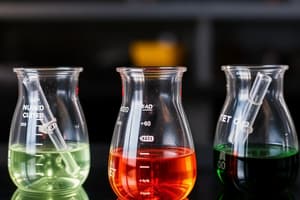Podcast
Questions and Answers
What is the oxidation number of chlorine in the chlorine molecule (Cl2)?
What is the oxidation number of chlorine in the chlorine molecule (Cl2)?
- 0 (correct)
- -1
- +2
- +1
What charge does chlorine acquire in hydrogen chloride (HCl)?
What charge does chlorine acquire in hydrogen chloride (HCl)?
- +1
- +2
- 0
- -1 (correct)
What is the oxidation number of sulfur in the molecule H2S2O7?
What is the oxidation number of sulfur in the molecule H2S2O7?
- +6 (correct)
- 0
- +2
- +4
What is the oxidation number of sulfur in the ion HSO3¯?
What is the oxidation number of sulfur in the ion HSO3¯?
In most compounds, what is the oxidation number assigned to oxygen?
In most compounds, what is the oxidation number assigned to oxygen?
In the compound NaClO3, what is the oxidation number of chlorine?
In the compound NaClO3, what is the oxidation number of chlorine?
What is the oxidation number of potassium in K2Cr2O7?
What is the oxidation number of potassium in K2Cr2O7?
What is the algebraic sum of the oxidation numbers in a neutral molecule?
What is the algebraic sum of the oxidation numbers in a neutral molecule?
What is the classical definition of oxidation?
What is the classical definition of oxidation?
In the reaction between PbO and carbon, which species is reduced?
In the reaction between PbO and carbon, which species is reduced?
Which of the following is an example of a reducing agent?
Which of the following is an example of a reducing agent?
What happens simultaneously during an oxidation-reduction reaction?
What happens simultaneously during an oxidation-reduction reaction?
What role does the zinc rod play in the electrochemical reaction?
What role does the zinc rod play in the electrochemical reaction?
Which observation indicates that a current is flowing in the electrochemical cell?
Which observation indicates that a current is flowing in the electrochemical cell?
Which of the following species is an oxidizing agent?
Which of the following species is an oxidizing agent?
During the electrochemical reaction, what happens to the copper rod?
During the electrochemical reaction, what happens to the copper rod?
What is a characteristic of non-spontaneous reactions in electrochemistry?
What is a characteristic of non-spontaneous reactions in electrochemistry?
What is the primary function of the salt bridge in the electrochemical cell?
What is the primary function of the salt bridge in the electrochemical cell?
What does reduction always involve?
What does reduction always involve?
Which of the following statements is true regarding the anode in the electrochemical cell?
Which of the following statements is true regarding the anode in the electrochemical cell?
In an electrochemical cell, what is formed at the anode?
In an electrochemical cell, what is formed at the anode?
What occurs to the zinc sulfate concentration during the reaction?
What occurs to the zinc sulfate concentration during the reaction?
What indicates that the reactions in the electrochemical cell will eventually stop?
What indicates that the reactions in the electrochemical cell will eventually stop?
Which ions are involved in the reduction process in the copper electrode?
Which ions are involved in the reduction process in the copper electrode?
What role does the salt bridge play in the Daniell cell?
What role does the salt bridge play in the Daniell cell?
Which component acts as the anode in a Daniell Cell?
Which component acts as the anode in a Daniell Cell?
During the operation of a Daniell Cell, what happens at the anode?
During the operation of a Daniell Cell, what happens at the anode?
How does the zinc anode contribute to the flow of electrons in the Daniell Cell?
How does the zinc anode contribute to the flow of electrons in the Daniell Cell?
What is the effect of the positive charge accumulation around the anode?
What is the effect of the positive charge accumulation around the anode?
In a Daniell Cell, which ions migrate towards the anode from the salt bridge?
In a Daniell Cell, which ions migrate towards the anode from the salt bridge?
What is a necessary condition for the continuous flow of current in a Daniell cell?
What is a necessary condition for the continuous flow of current in a Daniell cell?
What type of reaction occurs when copper is reduced in the Daniell cell?
What type of reaction occurs when copper is reduced in the Daniell cell?
What is the standard condition for measuring standard electrode potential?
What is the standard condition for measuring standard electrode potential?
What happens when the normal hydrogen electrode acts as an anode?
What happens when the normal hydrogen electrode acts as an anode?
Why is the absolute value of electrode potential difficult to determine?
Why is the absolute value of electrode potential difficult to determine?
Which factors affect the electrode potential?
Which factors affect the electrode potential?
In the normal hydrogen electrode setup, which component is used as the electrode?
In the normal hydrogen electrode setup, which component is used as the electrode?
What is the arbitrary electrode potential value assigned to the normal hydrogen electrode?
What is the arbitrary electrode potential value assigned to the normal hydrogen electrode?
What is the primary reaction occurring at the cathode during the electrolysis of sodium chloride solution?
What is the primary reaction occurring at the cathode during the electrolysis of sodium chloride solution?
How does the concentration of metal ions in a solution affect electrode potential?
How does the concentration of metal ions in a solution affect electrode potential?
What occurs in the reaction at the cathode of the NHE?
What occurs in the reaction at the cathode of the NHE?
Which statement correctly describes the role of the electrodes in an electrolytic cell?
Which statement correctly describes the role of the electrodes in an electrolytic cell?
In the electrolysis of aqueous sodium chloride, what species is produced at the anode?
In the electrolysis of aqueous sodium chloride, what species is produced at the anode?
What distinguishes a galvanic cell from an electrolytic cell?
What distinguishes a galvanic cell from an electrolytic cell?
During the electrolysis of sodium chloride, what is the overall reaction?
During the electrolysis of sodium chloride, what is the overall reaction?
What is the primary effect of water ionizing in the presence of sodium chloride during electrolysis?
What is the primary effect of water ionizing in the presence of sodium chloride during electrolysis?
How does corrosion occur in metals, based on the process described?
How does corrosion occur in metals, based on the process described?
What happens to sodium chloride in an aqueous solution when electricity is passed through it?
What happens to sodium chloride in an aqueous solution when electricity is passed through it?
Flashcards
Oxidation
Oxidation
Loss of electrons by an atom or group of atoms.
Reduction
Reduction
Gain of electrons by an atom or group of atoms.
Redox reaction
Redox reaction
A chemical reaction involving both oxidation and reduction.
Oxidizing agent
Oxidizing agent
Signup and view all the flashcards
Reducing agent
Reducing agent
Signup and view all the flashcards
Electrochemical cell
Electrochemical cell
Signup and view all the flashcards
Galvanic cell
Galvanic cell
Signup and view all the flashcards
Electrolytic cell
Electrolytic cell
Signup and view all the flashcards
Electrochemical Cell
Electrochemical Cell
Signup and view all the flashcards
Oxidation
Oxidation
Signup and view all the flashcards
Reduction
Reduction
Signup and view all the flashcards
Anode
Anode
Signup and view all the flashcards
Cathode
Cathode
Signup and view all the flashcards
Salt Bridge
Salt Bridge
Signup and view all the flashcards
Electron flow (in a cell)
Electron flow (in a cell)
Signup and view all the flashcards
Voltaic Cell
Voltaic Cell
Signup and view all the flashcards
Daniell Cell
Daniell Cell
Signup and view all the flashcards
Salt Bridge
Salt Bridge
Signup and view all the flashcards
Electrochemical Cell (Galvanic Cell)
Electrochemical Cell (Galvanic Cell)
Signup and view all the flashcards
Anode
Anode
Signup and view all the flashcards
Cathode
Cathode
Signup and view all the flashcards
Redox Reaction
Redox Reaction
Signup and view all the flashcards
Half-cell Reaction
Half-cell Reaction
Signup and view all the flashcards
Electrolyte
Electrolyte
Signup and view all the flashcards
Oxidation number of an element in its free state
Oxidation number of an element in its free state
Signup and view all the flashcards
Oxidation number of an ion
Oxidation number of an ion
Signup and view all the flashcards
Oxidation number of Fluorine
Oxidation number of Fluorine
Signup and view all the flashcards
Oxidation number of Oxygen in compounds
Oxidation number of Oxygen in compounds
Signup and view all the flashcards
Oxidation number rules for calculating oxidation number of an element in a molecule
Oxidation number rules for calculating oxidation number of an element in a molecule
Signup and view all the flashcards
Calculating oxidation number of Sulfur in H2S2O7
Calculating oxidation number of Sulfur in H2S2O7
Signup and view all the flashcards
Calculating oxidation number of sulfur in HSO3⁻
Calculating oxidation number of sulfur in HSO3⁻
Signup and view all the flashcards
Electronegativity and oxidation number
Electronegativity and oxidation number
Signup and view all the flashcards
Reduction Potential
Reduction Potential
Signup and view all the flashcards
Oxidation Potential
Oxidation Potential
Signup and view all the flashcards
Standard Electrode Potential
Standard Electrode Potential
Signup and view all the flashcards
Standard Hydrogen Electrode (SHE)
Standard Hydrogen Electrode (SHE)
Signup and view all the flashcards
Factors Affecting Electrode Potential
Factors Affecting Electrode Potential
Signup and view all the flashcards
Electrode Potential Units
Electrode Potential Units
Signup and view all the flashcards
IUPAC Electrode Potential
IUPAC Electrode Potential
Signup and view all the flashcards
Inert Electrode
Inert Electrode
Signup and view all the flashcards
Cathode
Cathode
Signup and view all the flashcards
Anode
Anode
Signup and view all the flashcards
Electrolysis of NaCl (aq)
Electrolysis of NaCl (aq)
Signup and view all the flashcards
Electrolytic cell
Electrolytic cell
Signup and view all the flashcards
Galvanic Cell
Galvanic Cell
Signup and view all the flashcards
Electrode placement in Electrolytic Cell
Electrode placement in Electrolytic Cell
Signup and view all the flashcards
Product at Cathode (NaCl(aq))
Product at Cathode (NaCl(aq))
Signup and view all the flashcards
Product at Anode (NaCl(aq))
Product at Anode (NaCl(aq))
Signup and view all the flashcards
Study Notes
Electrochemistry
- Simple oxidation-reduction reactions in a beaker
- Direct redox reaction
- Indirect redox reaction
- Electrochemical cells
- Working and description
- Representation
- Calculation of E° cell for galvanic cells (e.g., Daniel cell)
- Predicting redox reaction feasibility
- Non-spontaneous reactions (electrolytic cells)
- Corrosion of iron
- Conditions for corrosion
- Prevention of corrosion
Reduction and Oxidation
- Classical concept
- Oxidation: addition of oxygen or removal of hydrogen
- Reduction: removal of oxygen or addition of hydrogen
- Examples
- PbO + C → Pb + CO (PbO reduced, C oxidized)
- Cl₂ + H₂S → 2HCl + S (H₂S oxidized, Cl₂ reduced)
- Electronic concept
- Oxidation: loss of electrons
- Reduction: gain of electrons
- Reducing agent: species losing electrons
- Oxidizing agent: species gaining electrons
- Oxidation and reduction always occur simultaneously
- Oxidation numbers
- Arbitrary rules for assigning oxidation numbers, example
- Oxidation number of an element in free state is always zero
- Oxidation number of fluorine is -1 in all compounds; in case of peroxide, oxidation number of oxygen is -1 (e.g., H₂O₂)
- Arbitrary rules for assigning oxidation numbers, example
Oxidation Half and Reduction Half Reactions
- Redox reactions can be split into two half reactions
- Oxidation half-reaction: represents loss of electrons
- Reduction half-reaction: represents gain of electrons
- Examples of redox reactions broken down into half reactions
- Zn + Cu²⁺ → Zn²⁺ + Cu
- Zn → Zn²⁺ + 2e⁻ (Oxidation half-reaction)
- Cu²⁺ + 2e⁻ → Cu (Reduction half-reaction)
- Zn + Cu²⁺ → Zn²⁺ + Cu
Oxidation Number or Oxidation State
- Explains electron transfer in covalent compounds
- Used to balance ionic and redox reactions
- Determined by applying rules, examples
- Chlorine in Cl₂ has an oxidation number of 0
- Chlorine in HCl has an oxidation number of -1
- Sulfur in H₂SO₄ has an oxidation number of +6
Redox Reactions and Electrochemical Cells
- Aqueous redox reactions can occur directly or indirectly
- Electrochemical cells store electrical energy
Construction and Working of a Simple Electrochemical Cell
- Arrangement of a cell with zinc and copper electrodes
- Zn⁺⁺ is oxidized at the anode creating Zn²⁺ (aq) and electrons
- Cu²⁺ is reduced at the cathode creating copper atoms
- Salt bridge completes circuit, preventing charge build-up
- Direction of electron flow explained
- Anode is the oxidation electrode
- Cathode is the reduction electrode
Electrode Potential
- Defined as the potential between a metal and its ions in solution
- Standard electrode potential (E˚)
- Defined under standard conditions (298 K, 1 atm, 1 M concentration)
- Measurement of standard electrode potential
- Relationship between cell potential (E˚), and electrode potentials
Electrochemical Series
- Arrangement of elements in order of increasing standard reduction potentials
- Used to predict reactivity and redox reactions feasibility
Factors Affecting Electrode Potential
- Nature of electrode material
- Concentration of metal ions in solution
- Temperature
- Valency
Corrosion of Metals
- Slow destruction of metals by chemical attack
- Conditions for corrosion
- Presence of oxygen
- Presence of moisture
- Factors that increase the rate of corrosion
- Presence of another metal or impurity
Prevention of Corrosion
- Barrier protection (e.g., painting, plating)
- Sacrificial protection (e.g., galvanization)
- Anti-rust solutions
- Electrical protection (e.g., cathodic protection)
Electrolysis
- Chemical decomposition of electrolytes by passing electricity
- Electrolytic cells
- Components (electrolytic tank, electrolyte, electrodes, external energy source)
- Electrolysis processes (at cathode and anode)
- Examples including electrolysis of sodium chloride solution
Studying That Suits You
Use AI to generate personalized quizzes and flashcards to suit your learning preferences.




